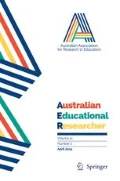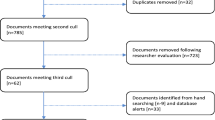Abstract
For millennia, stories and oral histories have been a fundamental way of sharing knowledge in many Aboriginal cultures. Honouring the role of stories can address a continuing lack of Aboriginal voices in Australian educational research literature. In this paper, we describe the philosophical underpinnings and methodology of our research, which aimed to learn from Aboriginal people about their post-school experiences, particularly in remote communities. The uniqueness of the project included training currently enrolled students as researchers to interview past students through yarning and storying. The collected stories were then interpreted and represented in audio recordings later developed into podcasts, writing, and through art. The aim of these research outcomes is to inform relevant policies and the development of teaching and learning resources for Aboriginal students. The way the methodology of our study evolved in response to the participants’ input is another key focus of this paper as well as having implications for future research.


Similar content being viewed by others
Change history
19 August 2021
A Correction to this paper has been published: https://doi.org/10.1007/s13384-021-00467-3
References
Australian Government. (2020). Indigenous Australia. Department of Foreign Affairs and Trade. Retrieved from https://www.dfat.gov.au/about-australia/land-its-people/Pages/indigenous-australia
Baeza, A. (2019). Exploring the lived experience of one Rural Teacher in Indigenous context in Chilean Northern Territory: A narrative inquiry. International Journal of Critical Indigenous Studies, 12(1), 29–45.
Baker, J. (2016). nitâcimowinis: A research story in Indigenous science education. In S. Marx (Ed.), Qualitative research in STEM: Studies of equity, access, and innovation (pp. 179–202). Routledge.
Battiste, M., & Henderson, J. Y. (2003). Protecting Indigenous knowledge and heritage. Purich.
Bessarab, D., & Ng’andu, B. (2010). Yarning about yarning as a legitimate method in Indigenous research. International Journal of Critical Indigenous Studies, 3(1), 37–50.
Blodgett, A., Schinke, R. J., Smith, B., Peltier, D., & Pheasant, C. (2011). In Indigenous words: Exploring vignettes as narrative strategy for presenting the research voices of Aboriginal community members. Qualitative Inquiry, 17, 522–533.
Brown, J. D. (2009). Foreign and second language needs analysis. In M. H. Long & C. J. Doughty (Eds.), The handbook of language teaching (pp. 269–293). Blackwell.
Cameron, R., Stuart, L., & Bell, T. (2017). Race based inequalities for Indigenous Australians’ participation and engagement in VET: A targeted review of the research. Journal of Vocational Education & Training, 69(3), 311–332.
Christensen, J. (2012). Telling stories: Exploring research storytelling as a meaningful approach to knowledge mobilization with Indigenous research collaborators and diverse audiences in community-based participatory research. The Canadian Geographer, 56, 231–242.
Creswell, J. W. (2013). Qualitative inquiry and research design: Choosing among five approaches (3rd ed.). SAGE.
Davis, K. A. (1995). Qualitative theory and methods in applied linguistics research. TESOL Quarterly, 29, 427–453.
Dean, C. (2010). A yarning place in narrative histories. History of Education Review, 39(2), 6–13.
Donovan, M. J. (2015). Aboriginal student stories, the missing voice to guide us towards change. Australian Education Research, 42, 613–625.
Forrest, S., & Johnson, M. (2017). Koolark koort koorliny: Reconciliation, art and storytelling in an Australian Aboriginal community. Australian Aboriginal Studies, 1, 14–27.
Geia, L. K., Hayes, B., & Usher, K. (2013). Yarning/Aboriginal storytelling: Towards an understanding of an Indigenous perspective and its implications for research practice. Contemporary Nurse, 46(1), 13–17.
Goodman, A., Snyder, M., Wilson, K., & Whitford, J. (2019). Healthy spaces: Exploring urban Indigenous youth perspectives of social support and health using photovoice. Health and Place, 56, 34–42.
Hyland, K., & Wong, L. C. (2013). Introduction. In K. Hyland & L. C. Wong (Eds.), Innovation and change in English language education (pp. 1–10). Routledge.
Iseke, J. M. (2011). Indigenous digital storytelling in video: Witnessing with Alma Desjarlais. Equity & Excellence in Education, 44(3), 311–329.
Kelly, J., Saggers, S., Taylor, K., Pearce, G., Massey, P., Bull, J. Odo, T., Thomas, J., Billycan, R., Judd, J., Reilly, S., & Ahboo, S. (2012). “Makes you proud to be black eh?”: Reflections on meaningful Indigenous research participation. International Journal for Equity in Health, 11(40), 1–8. Retrieved from http://www.equityhealthj.com/content/11/1/40
Kovach, M. (2009). Indigenous methodologies: Characteristics, conversations, and contexts. University of Toronto Press.
Lekoko, R. (2007). Storytelling as a potent research paradigm for Indigenous communities. Alternative: An International Journal of Indigenous Scholarship, 3(2), 82–95.
Little Bear, L. (2000). Traditional knowledge and humanities. Journal of Chinese Philosophy, 39(4), 518–527.
Marriott, R., Reibel, T., Coffin, J., Barrett, T.-L., Gliddon, J., Robinson, M., Griffin, D., & Walker, R. (2019). Wongi mi bardup (doing it our way). International Journal of Critical Indigenous Studies, 12(1), 15–28.
Martin, K., & Mirraboopa, B. (2003). Ways of knowing, being and doing: A theoretical framework and methods for Indigenous and Indigenist re-search. Journal of Australian Studies, 27, 203–214.
Mellor, S., & Corrigan, M. (2004). The case for change: A review of contemporary research on Indigenous education outcomes. ACER Press.
Mooney, J., Riley, L., & Blacklock, F. (2018). Yarning up: Stories of challenges and success. The Australian Journal of Education, 62(3), 266–275.
Phillips, L. G., & Bunda, T. (2018). Research through, with, and as storying. Routledge.
Rigney, L. I. (2001). A first perspective of Indigenous Australian participation in science: Framing Indigenous research towards Indigenous Australian intellectual sovereignty. Kaurna Higher Education Journal, 7, 1–13.
San Pedro, T., Carlos, E., & Mburu, J. (2017). Critical listening and storying: Fostering respect for difference and action within and beyond a native american literature classroom. Urban Education, 52(5), 667–693.
Sarra, C. (2010). Stronger smarter approaches to Indigenous leadership in education in Australia. In I. Snyder & J. Nieuwenhuysen (Eds.), Closing the gap in education? Improving outcomes in Southern World societies (pp. 195–203). Monash University.
Saunders, V., West, R., & Usher, K. (2010). Applying Indigenist research methodologies in health research: Experiences in the borderlands. Australian Journal of Indigenous Education, 39, 1–7.
Schwab, R. G. (2001). If you have a dream, you make it happen: Approaches to maximizing educational engagement among young Indigenous students. Canberra: Department of Education, Science and Training.
Shay, M. (2016). Seeking new paradigms in Aboriginal education research: Methodological opportunities, challenges and aspirations. Social and Education History, 5(3), 273–296. https://doi.org/10.17583/hse.2016.2299
Shay, M. (2017). Our mob are researchers too! The story of an Aboriginal researcher seeking new paradigms. In C. McMaster, C. Murphy, B. Whitburn, & I. Mewburn (Eds.), Postgraduate study in Australia: Surviving and succeeding (pp. 127–136). Peter Lang.
Shay, M. (2019). Extending the yarning yarn: Collaborative yarning methodology for ethical Indigenist education research. The Australian Journal of Indigenous Education. https://doi.org/10.1017/jie.2018.25
Shenton, A. K. (2004). Strategies for ensuring trustworthiness in qualitative research projects. Education for Information, 22, 63–75.
Simon, R., Eppert, C., Cloamen, M., & Beres, L. (2000). Witness as study: The difficult inheritance of testimony. The Review of Education/Pedagogy/Cultural Studies, 22(4), 285–322. https://doi.org/10.1080/1071441000220402
Simonds, V. W., & Christopher, S. (2013). Adapting Western research methods to Indigenous ways of knowing. American Journal of Public Health, 12(103), 2185–2192.
Simons, H. (2009). Case study research in practice. SAGE. https://doi.org/10.4135/9781446268322
Singh, M., & Major, J. (2017). Conducting Indigenous research in Western knowledge spaces: Aligning theory and methodology. Australian Educational Research, 44(5), 5–19.
Smith, L. T. (2005). Decolonizing methodologies: Research and Indigenous peoples. Zed Books.
Stake, R. E. (1995). The art of case study research. Sage.
The Healing Through Remembering Stories. (2005). What is story-telling? A discussion paper presented at the Story-telling as a Vehicle conference, Dunadry Hotel, Dunadry. Retrieved June 24, 2007 from http://cain.ulst.ac.uk/issues/victims/docs/healremember291105.pdf.
Watkin Lui, F. (2012). My island home: Re-presenting identities for Torres Strait Islanders living outside the Torres Strait. Journal of Australian Studies, 36(2), 141–153.
Williams, S. T. (2007). Indigenous values informing curriculum and pedagogical praxis. Deakin University. (Unpublished doctoral dissertation).
Willink, K. (2006). A passage toward homeplace. Cultural Studies ↔ Critical Methodologies, 6(4), 496–513.
Wilson, S. (2008). Research is ceremony: Indigenous research methods. Fernwood.
Funding
This study was supported by ARC Linkage (DLP180100331) awarded to Professor Rhonda Oliver and Dr Marnee Shay.
Author information
Authors and Affiliations
Corresponding author
Additional information
Publisher's Note
Springer Nature remains neutral with regard to jurisdictional claims in published maps and institutional affiliations.
The names “Rhonda Oliver” and “Helen McCarthy” were incorrectly swapped in the sentence “One member of the research team (Rhonda Oliver) was invited to visit the school weekly over a considerable period of time; others (Helen McCarthy and Boori Monty Pryor) also had a longstanding record of relationships with the school, having completed other workshops and projects there before…”. The correct statement is “One member of the research team (Helen McCarthy) was invited to visit the school weekly over a considerable period of time; others (Rhonda Oliver and Boori Monty Pryor) also had a longstanding record of relationships with the school, having completed other workshops and projects there before...”. And the author’s name “Helen McCarthy“ was published without the middle name initial. The correct name is “Helen CD McCarthy”.
Rights and permissions
About this article
Cite this article
Shay, M., Oliver, R., McCarthy, H.C. et al. Developing culturally relevant and collaborative research approaches: A case study of working with remote and regional Aboriginal students to prepare them for life beyond school. Aust. Educ. Res. 49, 657–674 (2022). https://doi.org/10.1007/s13384-021-00459-3
Received:
Accepted:
Published:
Issue Date:
DOI: https://doi.org/10.1007/s13384-021-00459-3



